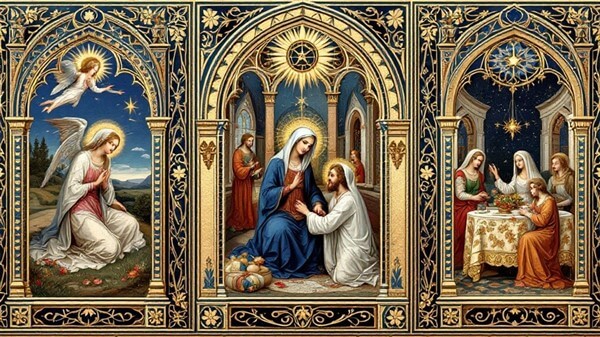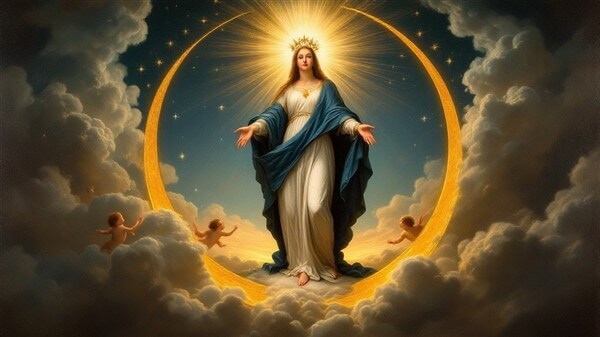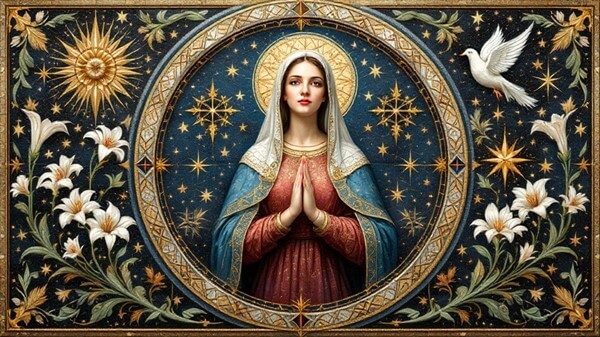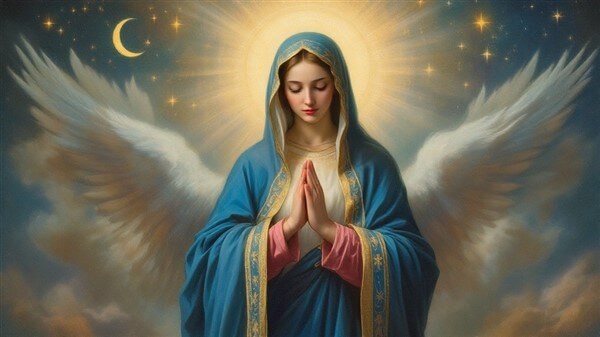Introduction

On December 8th, millions of Catholics worldwide celebrate the Feast of the Immaculate Conception, a celebration that honors one of the most profound mysteries of Christian faith. This doctrine, formally defined in 1854, proclaims that Mary, the mother of Jesus, was preserved free from original sin from the moment of her conception. Yet this feast represents far more than a single theological concept – it embodies centuries of reflection on Mary’s unique role in Christianity.
From the Gospel narratives to contemporary devotional practices, Mary’s story weaves together threads of divine grace, human response, and theological development. The Immaculate Conception stands as a testament to how Christian understanding of Mary has evolved, shaped by biblical interpretation, patristic wisdom, medieval debates, and modern spiritual expression.
This exploration will guide us through the biblical foundations of Marian devotion, trace the development of Mariology through centuries of Christian thought, and examine how the doctrine of the Immaculate Conception continues to inspire faithful celebration and artistic expression in our time.
Mary in Scripture and Early Christianity

Gospel Narratives
The Gospel accounts provide our earliest and most authoritative sources for understanding Mary’s role in Christian tradition. These narratives present Mary not merely as a passive vessel but as an active participant in salvation history.
The Annunciation in Luke
The Annunciation narrative in Luke 1:26-38 presents the pivotal moment of Mary’s encounter with the divine. The angel Gabriel’s greeting, “Hail, full of grace,” has become foundational in Marian theology. Mary’s response, “Let it be done unto me according to your word,” demonstrates her active participation in God’s plan. This dialogue reveals both divine initiative and human cooperation, establishing a pattern that would influence Christian understanding of salvation.
Mary’s Role in Jesus’ Ministry
Throughout the Gospels, Mary appears at crucial moments in Jesus’ life. From the nativity accounts to the finding in the temple (Luke 2:41-52), she is portrayed as a witness to and participant in her son’s mission. The Gospels show her as both mother and disciple, pondering events in her heart (Luke 2:19) while maintaining unwavering faith in her son’s divine mission.
The Wedding at Cana
John’s Gospel account of the Wedding at Cana (John 2:1-11) provides a unique insight into Mary’s intercessory role. Her simple statement, “They have no wine,” and instruction to the servants, “Do whatever he tells you,” demonstrates her confidence in Jesus’ power and her role in initiating his first public miracle. This episode has become emblematic of Mary’s continuing intercessory role in Christian tradition.
Early Christian Understanding
Patristic Writings on Mary
Early Church Fathers developed the first systematic reflections on Mary’s role. Justin Martyr, Irenaeus, and Tertullian explored her significance in salvation history. Their writings established fundamental themes in Marian theology, particularly regarding her virginity and divine motherhood. These early theological explorations laid the groundwork for later Marian doctrine.
Development of Marian Devotion
The earliest evidence of Marian devotion appears in the sub-apostolic age. The “Sub tuum praesidium” prayer, dating to approximately 250 AD, represents the earliest known petition to Mary. As Christianity spread, Marian devotion evolved from simple veneration to more elaborate forms of prayer and liturgical celebration, particularly in the Eastern churches.
The Concept of the New Eve
One of the most influential early interpretations of Mary’s role was her identification as the “New Eve.” Developed by writers such as Justin Martyr and Irenaeus, this parallel between Eve and Mary presented Mary as the one who undid Eve’s disobedience through her obedience. This typological interpretation became crucial for understanding Mary’s role in salvation history and later influenced the development of the Immaculate Conception doctrine.
Theological Development of Mariology

The Four Marian Dogmas
Divine Motherhood
The first and most fundamental Marian dogma, officially proclaimed at the Council of Ephesus (431 AD), declares Mary as Theotokos (God-bearer). This doctrine affirms that Mary is truly the Mother of God, not merely the mother of Christ’s human nature. This title underscores both the unity of Christ’s person and Mary’s unique role in the Incarnation.
Perpetual Virginity
This dogma affirms Mary’s virginity before, during, and after the birth of Jesus. Formalized in the Second Council of Constantinople (553 AD), it emphasizes the miraculous nature of Christ’s birth and Mary’s complete dedication to God. The doctrine reflects early Christian understanding of Mary’s unique sanctity and her role as a model of consecrated life.
Immaculate Conception
Defined by Pope Pius IX in 1854, this dogma declares that Mary was preserved from original sin from the moment of her conception. This preservation was not due to her own merit but through a singular grace of God in view of Christ’s redemptive work. The doctrine emphasizes God’s preparation of a worthy dwelling place for the Incarnate Word.
Assumption
The most recently declared Marian dogma (1950) teaches that at the end of her earthly life, Mary was assumed body and soul into heavenly glory. This doctrine completes the theological understanding of Mary’s unique privileges, seeing her bodily assumption as the culmination of her immaculate conception and divine motherhood.
Doctrinal Evolution
Medieval Debates
The medieval period saw intense theological discussion about Mary’s privileges, particularly regarding the Immaculate Conception. Theologians like Anselm of Canterbury and Bernard of Clairvaux contributed significantly to these discussions, though they sometimes reached different conclusions about the precise nature of Mary’s sanctification.
Franciscan-Dominican Discussions
A significant theological debate emerged between the Franciscan and Dominican orders regarding the timing of Mary’s sanctification. The Franciscans, led by Duns Scotus, championed the doctrine of the Immaculate Conception, while the Dominicans, following Thomas Aquinas, initially held that Mary’s sanctification occurred after conception but before birth.
Papal Declarations
The development of Marian doctrine has been marked by significant papal pronouncements. Key documents include Ineffabilis Deus (1854), defining the Immaculate Conception, and Munificentissimus Deus (1950), proclaiming the Assumption. These declarations represent the culmination of centuries of theological reflection and devotional practice.
The Immaculate Conception: Doctrine and Celebration

Theological Significance
Freedom from Original Sin
The doctrine of the Immaculate Conception affirms that Mary, from the first moment of her conception, was preserved from the stain of original sin. This unique privilege does not mean Mary had no need of redemption; rather, she was redeemed in a more perfect way through a “preventing grace” that preserved her from sin in anticipation of Christ’s saving work.
Divine Preparation
This doctrine emphasizes God’s providential preparation of a worthy dwelling place for the Incarnate Word. The preservation of Mary from original sin represents God’s perfect preparation of the one who would bear His Son. This preparation extends beyond mere physical motherhood to Mary’s spiritual role in salvation history.
Role in Salvation History
Mary’s Immaculate Conception positions her uniquely in the divine plan of salvation. As the New Eve, she represents humanity’s perfect response to God’s initiative. Her freedom from sin enabled her complete “fiat” to God’s will, making her the model of perfect discipleship and cooperation with divine grace.
Cultural and Liturgical Expression
Artistic Representations
The Immaculate Conception has inspired countless artistic works throughout history. Traditional iconography depicts Mary standing on a crescent moon, crowned with twelve stars, often crushing a serpent beneath her feet. This imagery, drawn from Revelation 12, became standardized after the doctrine’s formal definition, though earlier artistic representations exist.
Liturgical Celebrations
The Feast of the Immaculate Conception on December 8 is celebrated as a Holy Day of Obligation in many countries. The liturgical celebration includes specific prayers, readings, and hymns that reflect the theological richness of the doctrine. The feast’s placement during Advent connects it naturally to the preparation for Christ’s coming.
Global Devotional Practices
Devotion to the Immaculate Conception has taken various forms across cultures. From the Americas to Asia, local traditions have incorporated this doctrine into their spiritual practices. Notable expressions include the dedication of churches and nations to the Immaculate Conception, pilgrimages to related shrines (especially Lourdes), and various forms of popular piety.
Conclusion

The doctrine of the Immaculate Conception, far from being an isolated theological concept, represents the culmination of centuries of Christian reflection on Mary’s unique role in salvation history. From the biblical narratives through patristic writings to medieval debates and modern devotional practices, our understanding of Mary’s immaculate nature has deepened and evolved.
This journey through Scripture, tradition, and theological development reveals how the Church’s appreciation of Mary’s role has grown more profound over time. The December 8th feast day serves not only as a celebration of a theological truth but as a living reminder of God’s extraordinary grace and human potential for complete cooperation with divine will.
Mary’s Immaculate Conception continues to inspire believers today, offering a model of perfect discipleship and a window into God’s transformative power. As we conclude our exploration, we see that this doctrine, while honoring Mary’s unique privilege, ultimately points to Christ’s redemptive work and God’s perfect preparation for the Incarnation.
In an age seeking authentic spirituality and divine encounter, Mary’s Immaculate Conception offers both theological depth and practical inspiration, inviting contemporary believers to contemplate the mystery of divine grace and human response in their own spiritual journeys.


 ByKus
ByKus Historia
Historia Logos
Logos Humanitas
Humanitas Aesthetica
Aesthetica Cinemania
Cinemania Lingua
Lingua Mythos
Mythos Theologia
Theologia Bibliotecha
Bibliotecha Persona
Persona Quid
Quid News
News Politico
Politico Mundialis
Mundialis Oeconomia
Oeconomia Athletica
Athletica Technologia
Technologia Medicina
Medicina Scientia
Scientia Astronomia
Astronomia













